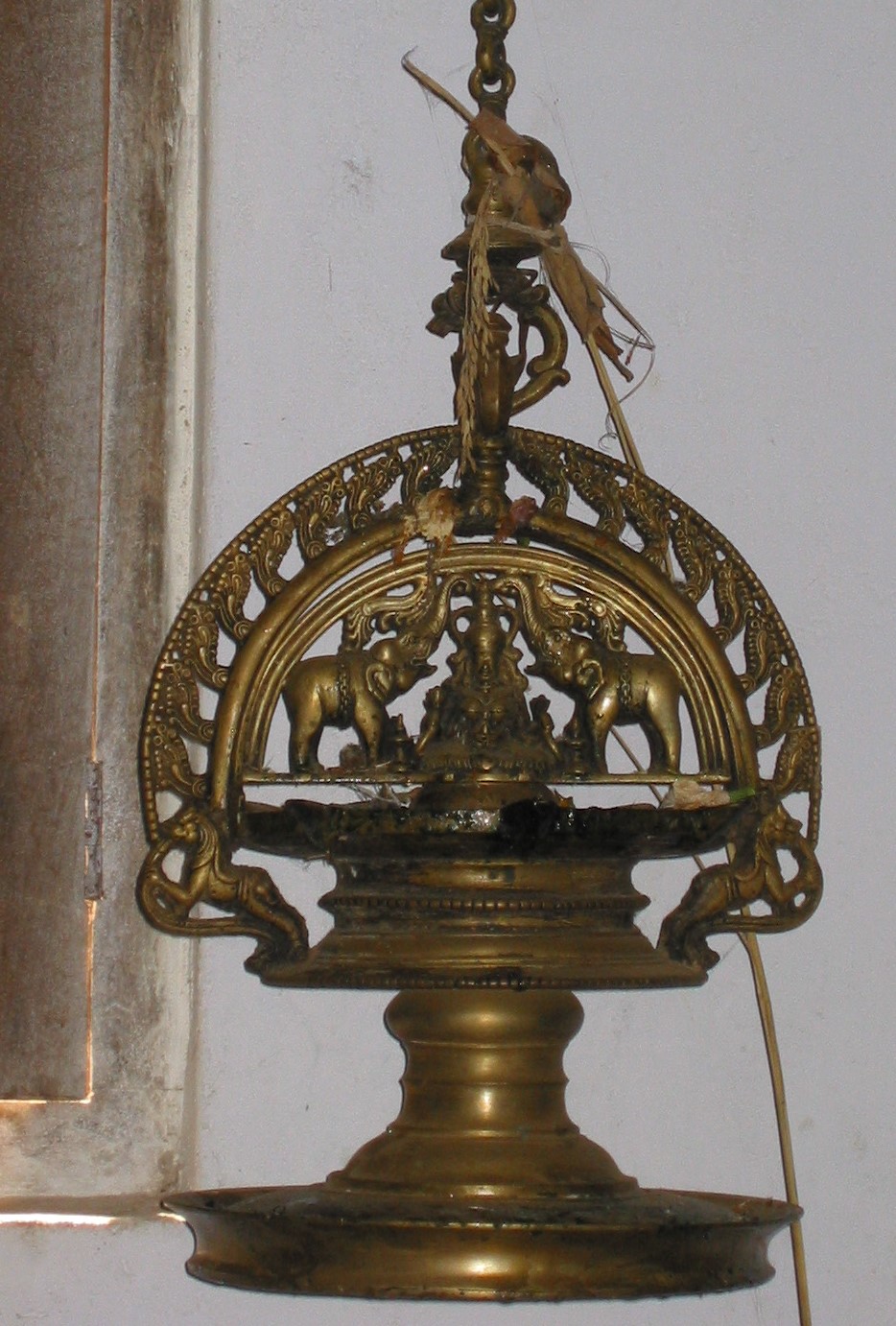
Death Rituals
The corpse of one who has just died is laid on a mat on the floor, with the head to the south, and sacred Kaveri theertha is trickled into the mouth. The corpse is usually taken to the ainmane of the okka to which the person belongs, and death ceremonies are conducted there.
Firing the gun
If the deceased was a married person or an elderly unmarried person, two rapid gunshots are fired in the air, and this is repeated at short intervals. If the person was unmarried, but old enough to be married, a single shot is fired. In the case of the death of a young person no shots are fired. The firing of gunshots is an intimation of the death to the people in the village.
Dressing the corpse
The corpse is taken outside the house, bathed, dressed in traditional attire. If the deceased is a man, he is dressed in a white kupya put on back to front so that it can be removed easily when the body is cremated. The sash is folded and placed on the waist and a pice katti is kept under it; a turban is placed on the head. If the deceased is a woman, she is dressed in a sari and blouse with the blouse put on back to front, and adorned with her jewellery.
Vibhuti is applied on the forehead of the corpse and a gold coin is fixed at the centre of the forehead with paste. A ball of vibhuti is placed on the chest. The hands are folded on the chest and a mirror placed in the hands. If the eyes are not shut, the lids are closed with the sap of a banana plant. Betel leaves and nuts are put into the mouth and the lips are covered with a piece of red silk cloth.
Cavu Kutuva (Lying in State)
The corpse is then laid in state on a mattress placed on a single mat that is spread upside down on a special cot (made with two planks of wood) in the nellakki nadu bade (central hall) of the ainmane, with the head of the body to the west. The corpse is placed in a leaning posture, with a rolled mattress kept against the back for support. The knees are bent as in a sitting posture if the deceased is a man, or kept straight if it is a woman. The body is placed on a white cloth that is folded over the body to cover the back of the head and legs. A canopy of red cloth is erected over the corpse.
A small oil lamp is lit and kept burning in the hall. A bell metal plate into which is poured Kaveri theertha or some coconut water, along with a few leaves of tulasi and some garike grass, is kept next to the head of the corpse.
Only ladies sit near the corpse. The chavu paat (funeral song) lamenting the dead is sung, and relatives wearing white come to mourn and pay their last respects.
Male relatives who are younger than the deceased wear two pieces of white cloth, one tied to the waist like a mundu and the other wrapped on the shoulders like a shawl. Younger female relatives cover their shoulders with a nippk thuni, a piece of white cloth knotted in front. Some women who are close relatives let their hair loose, and place a muri (piece of new white cotton cloth about five yards long) on their heads as they approach the corpse. One of the women of the house receives the muri and places it by the side of the head of the corpse.
Bayik nir kodpa (Giving water to the corpse’s mouth)
Mourners remove their head-dresses (vastras or turbans) and footwear before paying respects to the corpse. Each one dips the tulasi leaves and garike grass in the water in the plate and applies it to the lips of the corpse. The mourner then touches the chest of the deceased with the back of his/her palm and then touches his/her own chest with the palm as if beating the chest. Mourners may leave some money on a plate placed near the head of the corpse, as a contribution towards the funeral expenses.
Cremation
The body is then taken in a procession to the thutengala (cremation ground) of the okka where the last rites are performed. Close relatives stand facing each other, stretching out their hands and clasping the hands of those facing them. The corpse along with the mattress is placed on their hands and carried from the central hall to the courtyard where it is placed on the bier. Those who carry the bier should not wear footwear or turbans. The bearers lift the bier and rock it as they dance three rounds in a counter-clockwise direction. The procession goes to the cremation ground with the funeral song sung all along the way.
In the cremation ground, firewood for the pyre (at least one stick from a fresh green tree), is stacked in a North-South direction. The bier is carried thrice around the pyre in a counter-clockwise direction and laid on the ground to its West with the corpse’s head to the South.
The aruva places a small mud pot filled with water on the head of the husband/wife of the deceased; a coconut on the head of the son or daughter; and a kindi filled with water on the head of a nephew/niece. A mango leaf is placed in the pot and in the kindi and the person carrying a coconut is given a mango leaf. A small hole is made in the mud pot and in the coconut. These three then go in a procession with the nephew/niece leading, followed by the son/daughter and then the wife /husband. A piece of white cotton cloth about five yards in length is carried as a canopy over their heads by two men, one in front and one at the back, with the aruva holding it up at its centre with a stick.
The three walk thrice around the bier and the pyre in a counter-clockwise direction, sprinkling water on the ground with the mango leaves. The water spilling out of the pot, the coconut and the kindi as they walk symbolizes the ebbing out of the life of the deceased.
The husband/wife then stands at the head of the corpse to its left, the son/daughter at its foot and the nephew/niece to its right, and the memadi is removed. A little water from each of the containers they carry is poured into the plate from which water is offered to the deceased.
The husband/wife then touches the bier twice with the pot that he/she is carrying, dashes it to pieces against the bier and throws the pieces under the bier. Similarly, the son/daughter touches the bier thrice with the coconut, breaks the coconut with a knife and throws the pieces under the bier. The nephew/niece touches the bier thrice with the kindi and places the kindi upside down under the bier.
If the deceased does not have a husband/wife, son/daughter, nephew/niece, other close relatives may perform these rites.
The corpse is then stripped of all jewels. In place of the gold coin on the forehead, a silver coin is affixed. The jewels are tied in a bundle and two persons, one on each side of the bier, pass the bundle thrice around, underneath and above the bier, and then hand them over to a responsible member of the family of the deceased.
The clothes on the body are removed, and a white cloth is spread over the body from head to foot. Three women anoint the corpse by smearing the shroud with turmeric coloured oil, with the palms of their hands twisted outwards in the terangai way. Thereafter, the corpse is placed on the funeral pyre, and the wife/husband or a close relative places a flaming torch under the funeral pyre to light it, holding the torch in the terangai way. It is notable that Kodava custom is unlike the common Hindu custom where the eldest son of the deceased is required to light the pyre. Close relatives then leave the cremation ground.
Villagers supply food to the house in mourning since no cooking may be done there until the corpse is removed.
Kari Madakuva (Removing the ashes)
The aruva, members of the family of the deceased and other close relatives go to the cremation ground the next morning. They quench the fire and gather the ashes and bones and immerse them in a river. If this is not possible, the ashes and bones are buried at the base of a sap-exuding tree, and later a small quantity may be immersed in a river.
Ritual Mourning
Mengate Nippad (Staying apart during mourning)
In the family of the deceased and among his/her close relatives, those who are younger than the deceased should remain mengate during the period of mourning which ends on the maada day Men who remain mengate shave their heads (leaving a tuft of hair at the back of the head), beards and moustaches. Until the period of mengate or mourning is over they should not shave or wear any jewellery, red sashes or red kerchiefs. Women who remain mengate should remove all their jewellery, and should wear nippk tuni during the mourning period.
Those who remain mengate should not eat meat, fish, mushrooms, honey, betel leaves and areca nuts, or drink milk or liquor, and should not attend marriages or auspicious ceremonies during the mourning period. Members of the okka who are older than the deceased and therefore do not remain mengate, may also not attend marriages or auspicious ceremonies during that period.
Kulik Nippad (Rituals observed by the closest mourners)
The husband/wife of the deceased and one or two close relatives should, besides remaining mengate, observe kulik nippad until the maada ceremony. Males among them should shave their heads and faces completely and may not shave again until the period of mourning is over. They should wear a white mundu around the waist and a white shawl over the shoulders. Women should wear nippk tuni over their saris.
Those who observe kulik nippad should cook separately for themselves on a fireplace made from three stones placed outside the house. They should bathe every day and eat only one meal a day.
Offerings to the Spirit of the Deceased
The spirits of deceased persons, are believed to reside in creatures that live in water, land or air. Nir beli is offerings to creatures that live in water, kare beli is to those that live on land and kakek kul beppa is to those that live in the air.
Nir Beli (Offerings in water)
On each of the first three days after the start of mengate, those who observe kulik nippad go to a tank or well and drop some rice in the water for the fish to eat. This is known as nir beli.
Kare Beli (Offerings on the bank of a tank or well)
From the fourth day up to the seventh day after the start of mengate, those who observe kulik nippad perform kare beli. They place three stones to make a fire-place on the bank of the tank or well where they did the nir beli. A piece of a broken earthen pot is placed on the fire-place. A little water and a few grains of rice are put in it and cooked using firewood. The cooked rice is removed and placed on the top section of a banana leaf and left on the bank of the tank or well.
Beli Mara (Post on which offerings are placed)
On the seventh day after the start of mengate, the aruva plants one or three posts in the back-yard of the house and nails small planks on the tops of the posts. These posts are called beli mara.
Kakek Kul Beppa (Offerings to crows)
From the seventh day up till the eleventh day after the start of mengate, before having his/her meal, the husband/wife of the deceased takes some of the rice and curry that he/she cooked that day, puts it on a banana leaf and places the leaf on top of the plank nailed to the beli mara. Then he/she claps thrice, calling the crows “Ka, ka, ka”. This is known as kakek kul beppa. He/she watches for some time to see if crows eat the food offering, and if they do so in his/her presence, it is believed that the deceased is satisfied with the offering.
Maada
The maada (ceremony that ends the period of ritual mourning) is usually held on the eleventh day after death, or on any convenient day following the eleventh day, fixed by the family members. Because no auspicious event can be celebrated until the maada, it may be advanced to the seventh day after death.
Early in the morning on this day the aruva cuts down the beli mara, and the mourners who observe kulik nippad dismantle the stones that were put up for cooking outside the house. Thereafter all those present are served a grand meal.
A portion of the food prepared for the occasion is offered at the thutengala for the departed soul. The polichi pat (laudatory song) in praise of the dead person is sung on this occasion.
On the maada day, all those who ended mengate, other than those who observe kulik nippad, may now wear their usual clothes and jewellery, without any restrictions; and the males among them have their faces shaved by the barber after their meal.
Tike Uttuva (End of Ritual Mourning for those who observe Kulik Nippad)
The period of ritual mourning for those who observe kulik nippad ends with the tike uttuva ceremony at a place of pilgrimage. This may happen weeks or months after the maada.
After the tike uttuva ceremony, all except the wife of the deceased may wear their usual clothes and eat and drink without any restrictions. The widow should not wear attractive clothes, excessive jewellery, glass bangles or toe-rings unless she gets married again.
Takk Pariciduva
It is customory for relatives and friends to visit the bereaved to offer condolences. This is called takk pariciduva, literally ‘making them (the bereaved) talk’ to express their grief.
Source: Pattole Palame

